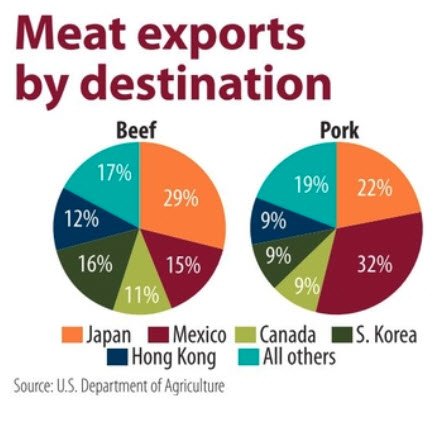Prices for beef are rising due to substantial demand.
As of March 9, the U.S. Department of Agriculture’s composite beef cutoff value was up 10% from the start of the year and up 2% from the same date last year. In contrast, the pork cutout value had down 6% since January 1 and was down 11% from the same date last year. Red meat and poultry are in plentiful supply, therefore demand is driving the market, with beef appearing to be the clear victor.
According to U.S.D.A. data, U.S. beef (and veal) exports reached a new high of 2,862 million pounds in 2017, up 12% from the previous year and marking the second consecutive year of double-digit growth. Shipments to Japan, the country that purchases the most American beef, increased by 26% over 2016 and accounted for 29% of all U.S.
In line with its February forecast, which was up 40 million pounds from January and up 163 million pounds, or 6%, from 2017, the U.S.D.A. predicted on March 8 that U.S. beef exports would reach a record 3,025 million pounds in 2018. This was “based on continuing strong demand in overseas markets and the weakening of the U.S. dollar,” along with “continued tightness of beef availability from Oceania.”
The United States’ beef supply is also growing, albeit more slowly, during this period. In its semi-annual Cattle Inventory report, the U.S.D.A. reported that there were 94.4 million cattle as of January 1st, up 0.7% from the previous year and in comparison with rises of 1.9% on January 1st, 2017, 3.1% in 2016 and 0.7% in 2015, which was an increase from an inventory in 2014.
The drought in the southern Plains has also affected the supply of beef this year. It has decreased grazing on pasture and wheat and caused an abnormally high number of cattle to be moved into feedlots in late 2017 at lighter weights. First-quarter marketings are predicted to fall because to the extended feed times for those cattle, but second-quarter sales are probably going to rise, which will somewhat alter the usual supply of beef to the market. The total amount of beef produced in 2018 is expected to increase by 6% over 2017.
The demand for pork is still very strong, although prices seem to be contained by increased output. The U.S. Department of Agriculture raised its 2018 production prediction in March by 25 million pounds from February, with a 5% rise in output over 2017. The March rise was justified by the U.S.D.A. based on higher slaughter weights, which more than compensated the lower number of pigs sold. The U.S.D.A. attributed the increase to strong producer returns, pleasant winter weather in major producing areas, and moderate but still growing feed costs. The U.S.D.A. stated in February that since it was unclear whether consumer demand for pork was keeping up with production increases, higher hog prices may have been more the product of increased packer slaughter capacity.
Pork exports have been robust, much like beef exports. Exports made up 22% of US pork production in 2017 (as opposed to 11% for beef), and 6% more is predicted in 2018 to keep the percentage at 22%. Lower pig prices in 2018 are anticipated, which is thought to encourage more exports. With 32% of all US pork exports in 2017, Mexico is by far the biggest consumer of US pork, followed by Japan (22%), Canada, South Korea, and China/Hong Kong (just over 9% apiece).
The most recent data available as of January 31 shows that there were significant differences in freezer meat stocks across beef, pig, and poultry, which is only one measure of demand. At 499,554,000 pounds, frozen beef inventories were 7% lower than a record high from the previous year. As of January 31 of this year, overall poultry stocks were at a record high of 1,252 million pounds, up 8% from the previous year (a record high reached in January 2016), while neither turkey nor chicken were at record levels on their own. Lower belly pricing so far this year and much higher pork belly stocks—the raw material for bacon—which as of January 31 were up 219% from record lows a year earlier were considered to be key contributors in the decline in the overall cutout value of a pig carcass.
In the upcoming months, other factors will also affect the production, exports, and availability of meat and poultry. These factors include weather, trade concerns (which are still unpredictable), feed prices (corn values are rising due to strong export demand and Argentine weather woes), and corn prices.
